
PREV ARTICLE
NEXT ARTICLE
FULL ISSUE
PREV FULL ISSUE
SEPTEMBER, 2020 GOLDBERG SALE SELECTIONSHere are some lots that caught my eye in the Ira & Larry Goldberg Auctioneers September 2020 sale. -Editor
Lot 2010: Syracuse. Dionysios I. Silver Decadrachm 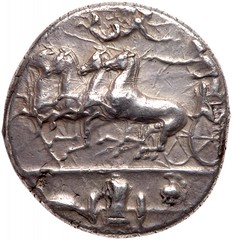
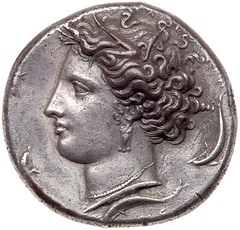
Sicily, Syracuse. Dionysios I. Silver Decadrachm, 405-367 BC. Ca. 405-400 BC. Reverse die signed by the master engraver Euainetos. Charioteer driving galloping quadriga left, holding kentron and reins; above, Nike flying right, crowning charioteer with wreath; below heavy exergual line, military harness, shield, greaves, cuirass, and Attic helmet, all before a horizontal spear. Reverse: Wreathed head of Arethusa left, wearing triple-pendant earring and necklace, surrounded by four dolphins; below neck truncation [EY-AIN]E. Gallatin dies R.IV/C.XI; SNG ANS 366 (same obv. die). Boldly struck in high relief. Probably cleaned long ago, a thin layer of horned silver (silver oxide) has been expertly removed, showing the details of Arethusa's hairline engraved by the master Euainetos, now a pleasing light grey. About Extremely Fine. Estimated Value $15,000 - UP
Amongst the most famous of all ancient Greek coins, the decadrachms of Syracuse were struck to finance the military ambitions of the tyrant, Dionysios I, who made Syracuse the most powerful of the western Greek city-states. The master artists Kimon and Euainetos worked at the mint, and both sometimes signed their dies. However, the styles are sufficiently distinct that even on unsigned dies the hand of the engraver can easily be determined. Euainetos's coins were especially regarded in ancient times even as they are today, and served as inspiration for the coinage of a number of other cities throughout the Greek world.
Love the galloping quadriga. -Editor
To read the complete lot description, see:
Lot 2013: Macedonia, Akanthos. Silver Tetradrachm 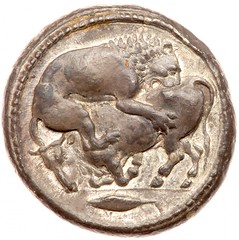
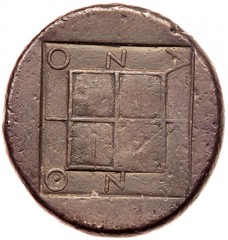
Macedonia, Akanthos. Silver Tetradrachm (17.19 g), ca. 470-430 BC. Lion right attacking bull standing left; in exergue, fish left. Reverse: AK-ANT-IO-N within square border surrounding quadripartite incuse square. Desneux 97 (D94/R87); AMNG III/2, 21; HGC 3, 385. Fantastic style and beautiful deep grey find toning.
This tetradrachm was struck at Akanthos in the decades between the repulse of the Persian invasion of Greece (480-479 BC) and the outbreak of the Peloponnesian War (431-404 BC), a period in which the Athenians were very active in establishing influence over the cities of coastal Macedonian and Thrace through membership in the Delian League. Akanthos had become a member of the League by 450 BC, but the city seems to have tired of Athenian domination in the early years of the Peloponnesian War. In 424 BC, the Akanthians secretly voted to secede from the Delean League and supported the Spartan general Brasidas and the Chalkidian League against Athenian interests in Macedonia. The use of the Attic weight standard (ca. 17.2 g) for this coin reflects Athenian influence at the time of its production. After 424 BC, Akanthian coins normally employ a lighter Chalkidian standard (ca. 14.4 g). While not so common on Greek coins, the obverse motif of a lion attacking a bull enjoyed great popularity throughout the ancient Near East and may have been adopted by Akanthos through its exposure to Persian culture. The Akanthians are known to have been on friendly terms with the Persians by 480 BC, when they welcomed Xerxes I and his army. The reverse quadripartite incuse design surrounded by a legend was widely used on contemporary coins struck in Macedonia and Thrace. It occurs on issues of the Macedonian king Alexander I as well as on coins of the Bisaltai and Edones and cities like Abdera and Mende.
That's a lot of bull! -Editor
To read the complete lot description, see:
Lot 2078: Cyprus, Amathos Silver Stater 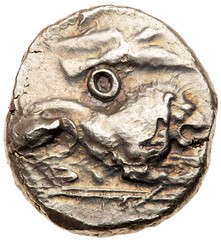
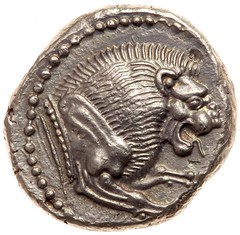
Cyprus, Amathos. Uncertain king. Silver Stater (11.37 g), ca. 450-435 BC. Lion crouching right; above, eagle flying right; between lion and eagle, large O (added to the die); in exergue, Cypriot 'mo' (very faint). Reverse: Forepart of lion right, with mouth agape. Amandry 126, 1 (same obv. die, but with 'O' added); Traité II 1262 and pl. CXXXII, 17; BMC 3 and pl. XVIII, 3 (same); Tziambazis 2 (same). Extremely Rare. Possibly the finest of only a few examples known.
This rare stater 'illustrates the variety of cultural influences at work at Amathos and Cyprus in general in the mid-fifth century BC. The lions here appear as symbols of royal power common to Greek, Phoenician, and Persian traditions. The recumbent lion recalls archaic issues of Ionian Miletos, yet the treatment of the ribs and mane suggest Phoenician and Persian influence. At the same time, the inscription abbreviating the name of the city is written in neither Greek nor a Semitic script, but rather using the Cypriot syllabary, a native writing system derived from the Linear A script of the Minoan Bronze Age.
Great lion. -Editor
To read the complete lot description, see:
Lot 2092: Seleukid Kingdom Silver Tetradrachm 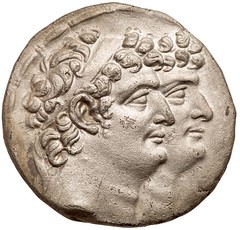
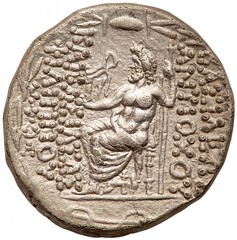
Seleukid Kingdom. Antiochos XI Epiphanes Philadelphos and Philip I Philadelphos. Silver Tetradrachm (15.8 g), circa 94-93 BC. Uncertain mint 127, in Cilicia (probably at Tarsos). Jugate and diademed heads of Antiochos XI and Philip I right. Reverse: BASI?EOS ANTIO?OY KAI BASI?EOS FI?I??OY, Zeus enthroned left, holding Nike and scepter; in outer left field, monogram above A; below throne, F; all within laurel wreath. SC 2438 (same obv. die); HGC 9, 1297 (same obv. die). Extremely Rare and of the utmost importance. One of just three known examples and the only example with clear controls. In the early first century BC, the Seleukid Empire was dying. Not a "go gentle into that good night sort of death," but a loud crashing doom, attended by flame and the spilling of blood. In 94 BC, Seleukos VI Epiphanes had been driven out of Syria by his uncle, Antiochos X Eusebes, and began to regroup at Mopsos, his base in Cilicia. Unfortunately, the harsh measures he used to raise money for a new round of warfare against Antiochos X turned the Mopsians against him and Seleucus VI was burned alive in his palace. When news of this shocking development reached his brothers, Antiochus XI and Philip I, they marched out of their own Cilician base, possibly at Tarsos, and sacked Mopsos in revenge. Once the Mopsians had been dealt with, Antiochos XI and Philip I then began to plan the fall of their uncle and the recapture of Antioch. While Philip I remained in Cilicia, in 94/3 BC, Antiochos XI entered Syria and briefly expelled Antiochos X from Antioch. Alas, the latter soon returned with a new army and Antiochos XI was drowned during a battle on the banks of the Orontes River. Philip I only managed to seize the Syrian capital after the death of his uncle and the capture of his third (and rival) brother, Demetrios III Eukairos, by the Parthians in ca. 88 BC, but by then, the Seleukid Empire consisted of very little else but the city of Antioch and its surrounding territory. Under Philip I, the once-great creation of Seleukos I crawled into its coffin. All that remained was to wait for the Romans and the nails. Wow! Amazing, powerful portraits. -Editor
To read the complete lot description, see:
Lot 1738 George II 5 Guineas 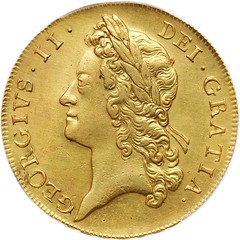
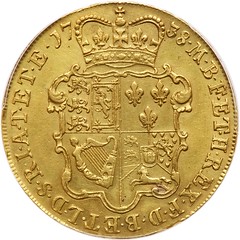
Great Britain. 5 Guineas, 1738. S.3663A; Fr-332; KM-571.1. George II, 1727-1760. DVODECIMO edge. Young laureate head left. Reverse; Crowned shield of arms. PCGS graded About Uncirculated, Detail (Repaired). Estimated Value $5,000 - 7,000
To read the complete lot description, see:
Lot 2506: 1676 Charles II Crown 
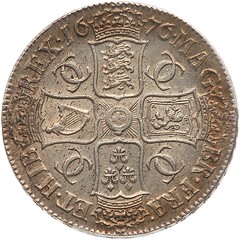
Great Britain. Crown, 1676. S.3358; ESC-51; Dav-3776. Charles II. 3rd bust 1676. Obverse portrait of king by John Roettier (1631-1700). Reverse, crowned cruciform shields with interlinked C s in angles. Edge reads VICESIMO OCTAVO in raised lettering. Nearly uncirculated for issue, but probably struck from slightly worn dies. After the return of the monarchy in 1660, Charles II welcomed the changes in the production of coinage. In the period 1662-3 the old fashioned hand hammering procedure was finally superceded by the use of the machinery of Pierre Blondeau. John and Joseph Roettier engraved dies for the larger coins with a raised edge inscription and this virtually ended the criminal practice of clipping small pieces of precious metal from the edge of the coins. Charles II's reign was marked by some religious discord and certain foreign wars and costly skirmishes, but generally, Charles's position was secure, and he was careful to be more pragmatic in his dealings than his father, the ill-fated Charles I. Charles II was a great patron of the arts and science and he was popular among the people of England.
To read the complete lot description, see:

Wayne Homren, Editor The Numismatic Bibliomania Society is a non-profit organization promoting numismatic literature. See our web site at coinbooks.org. To submit items for publication in The E-Sylum, write to the Editor at this address: whomren@gmail.com To subscribe go to: https://my.binhost.com/lists/listinfo/esylum All Rights Reserved. NBS Home Page Contact the NBS webmaster 
|